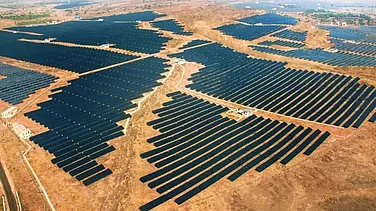The Central Pollution Control Board (CPCB) has released draft guidelines for the safe storage, handling and transportation of waste related to discarded solar photovoltaic (PV) modules, panels and cells on June 4, 2025.
According to a 2023 research by Centre for Study of Science, Technology & Policy, the waste resulting from photovoltaic panels is expected to generate 4.5 million tonnes by 2050. This marks a crucial step in India’s plan to manage the growing volume of solar waste, as the country expands its renewable energy capacity.
The guidelines, issued under the E-Waste (Management) Rules, 2022, come as India’s cumulative solar installed capacity as of June 13 was reported to reach 110.83 gigawatts(GW) by the Ministry of New and Renewable Energy. The capacity encapsulates installations across ground-mounted, rooftop and floating plants. With a solar parks in the pipeline, effective end-of-life management of solar panels becomes crucial.
According to the Chapter V of the E-Waste (Management) Rules, 2022, solar PV waste categorised as an e-waste. Unlike other electronic waste, solar PV waste is exempt from the EPR recycling targets.
But every manufacturers, producers and recyclers must ensure mandatory registration and should have storage permissions until 2034-35, annual return filings and compliance with CPCB standard operating procedures.
Meanwhile, the guidelines operate on the principle that producers and manufacturers will establish comprehensive collection mechanisms from consumers and bulk users, create take-back programmes with various stakeholders to prevent improper disposal.
Handling Solar Waste Risks
Unguided disposal of solar panels could cause significant environmental and health hazards due to presence of elements such as heavy metals, including lead, selenium, copper, silver, cadmium, arsenic, antimony, gallium, tellurium and tin contained within the modules. Improper disposal could also contaminate soil and water bodies, whereas uncontrolled burning could pollute air quality due to toxic fumes. This could potentially have adverse health impacts on communities and workers handling the waste without proper protective measures.
According to a 2026 study by the International Renewable Energy Agency (IRENA), the global PV waste will touch 78 million tonnes by 2050, with India being one of the top five PV waste creators. This makes developing a robust waste management crucial for preventing environmental harm since the country is among one of the fastest-growing solar markets.




























